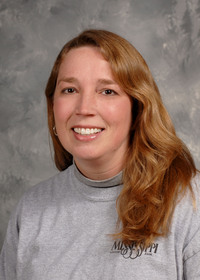Information Possibly Outdated
The information presented on this page was originally released on November 24, 1997. It may not be outdated, but please search our site for more current information. If you plan to quote or reference this information in a publication, please check with the Extension specialist or author before proceeding.
Dirty Chimneys Create Hazards
MISSISSIPPI STATE -- On winter evenings, few things can top the warmth of a wood heater, but these can turn dangerous if not installed and maintained properly.
Andy Sharp, a Starkville fire fighter and chimney sweeper, works both with preventing and putting out chimney fires. On average, Starkville has five to 10 chimney fires a year, he said.
"Very rarely does the house catch on fire, but nine times out of 10, the chimney is damaged by a chimney fire," Sharp said. "The chimney is not designed to have a fire, and a fire inside it can crack the inside and outside."
Dannie Reed, Choctaw County extension agent, said improperly cleaned, maintained or used wood heaters damage or destroy many houses in the state each year.
Fireplaces rarely cause problems as these are open to the air, burn cooler and usually do not accumulate tar in the chimney. Wood heaters, as well as enclosed fireplaces and Franklin stoves, cause more problems.
Safe wood heaters start with proper installation.
"Installing a wood heater is more than just putting a heater in and running pipe through the roof," Reed said.
Sometimes new fireplaces or heaters are simply connected to existing fireplaces or pipes are built that do not satisfy fire safety codes. Proper clearances are very important.
"The best approach is to use a chimney system following the specific plans of the manufacturer and correctly matching that system to the wood heater," Reed said.
Two or more inches of clearance around chimneys is usually required to meet safety codes. This applies to brick and mortar as well as insulated pipes that are close or in contact with building materials. Follow all building codes and instructions when installing wood heaters.
"Never use a single stovepipe as a chimney going through walls or into the attic," Reed said. "These should be at least 18 inches from combustible materials in the heated room."
Properly installed stovepipes and chimneys face another danger in creosote and soot buildup.
"The best way to reduce creosote and soot is to not keep a smoldering fire 'choked down' in an airtight heater," Reed said. "Use just enough wood to keep the fire burning, allow in enough air to have a flame and only start a fire when you need one."
But even with these precautions, chimneys must be cleaned to prevent fires. Sharp recommended yearly chimney inspections.
"A clean chimney is a safe chimney," Sharp said. "If you keep it clean, there is no way for a chimney to catch on fire."
If a chimney fire does start, call the fire department. Wood heaters have dampers that sometimes can be closed to block the air flow to the fire. Water also can be sprayed on the roof to prevent the fire from spreading.
"A chimney fire can spew burning creosote onto the roof and melt down or crack good chimney systems," Reed said.
Chimney fires require specific conditions to start. There must be enough creosote in the chimney to sustain a fire and enough heat to start one. Creosote ignites at temperatures of 800 degrees or higher.
"Christmas wrappings cause a lot of chimney fires each year because they burn quickly and often float up the chimney burning," Sharp said.
Another fire hazard is flammable material near the fireplace or heater, especially around the door. Use flameproof floor covering instead of carpet around these fixtures.
"When starting a fire, do not use combustible liquids or fuels, but use dry wood, pine heart or other starter wood sticks," Reed said. "Fuels can cause explosions or uncontrollable fires and should only be used outside. They have no place inside the living area of the home unless used as directed for special heating equipment."


